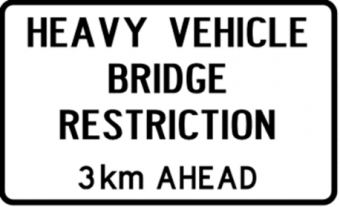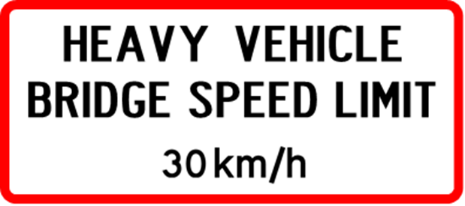RCAs can recommend that heavy vehicles use particular routes for safety and environmental reasons and / or are restricted from others. The recommended routes can be for:
Heavy vehicle restriction signs can be used to indicate bypass routes, effluent sites and engine braking restrictions. These types of signs are described in Table 15‑5.
Bypass route signs (as shown in Table 15‑5) can be either:
Additional marker signs can be used along the bypass route to help guide traffic. Additional information on types of route markers can found in TCD manual Part 2.
Where advance warning of a regulatory restriction is provided, signage should be ‘Advisory’, not use the red border or blue background.
The selection criteria and location of these sites are determined by Regional Councils.
Engine braking restrictions are normally developed as part of the RCA bylaw process. These restrictions can also be added to the text provided on a regulatory information sign or use sign A45-5. These signs are shown in Table 15‑5.
The permitted routes for use by HPMV and 50 Max vehicles are shown on Waka Kotahi NZ Transport Agency maps and permits.
Table 15‑5: Heavy vehicle restrictions, bypasses, route markers, stock effluent sites and engine braking restrictions
|
Sign code |
Example |
Description/use |
|---|---|---|
|
R5-3 No heavy motor vehicles |
|
Should be used to indicate a section of road where the RCA has restricted entry of heavy motor vehicles: ‘No Heavy motor vehicles beyond the sign’. For sign location, see note 1. |
|
R5-4 Height restriction |
|
Should be installed at the structure abutment or on the approach to the structure or section of road at a location where heavy vehicles can turn around. For sign location, see note 1 |
|
R5-7 Road classification - class C |
|
Where a road is likely to suffer excessive damage from heavy motor vehicles and the road has had a rating of Class C confirmed by the NZ Transport Agency an R5-7 sign may be installed. Heavy motor vehicles can only be operated on Class C roads to deliver or collect goods or passengers to, or from, locations along that road. For sign location, see note 1. |
|
R5-7.1 Road classification - class I |
|
This sign may be used to identify that a road is Class 1 road and able to carry vehicles of standard maximum mass and size unless a special weight or size limit applies. For sign location, see note 1. |
|
A45-6 |
 |
An A45-6 should be used to inform drivers of heavy vehicles of a bridge restriction at a specified distance ahead '_' km to give them time to take an alternate route or turn around. |
|
R5-8 Heavy vehicles - maximum length |
|
Where the RCA has assessed the maximum lengths of heavy vehicles that can use the road beyond the sign. For sign location, see note 1. |
|
R5-9 Heavy vehicle - bridge limits |
|
Used to indicate restrictions for heavy vehicles on a bridge - axle sets. For sign location, see note 1. |
|
|
Used to indicate restrictions for heavy vehicles on a bridge - number of axle sets and gross weight. For sign location, see note 1. |
|
|
Vertical format:
Horizontal format:
|
Used to indicate restrictions for heavy vehicles on a bridge - number of axle sets or number of axle sets and gross weight or speed. Type A is in vertical format; the choice of Type A or B is determined by the bridge site and available road verge on the approaches to the bridge. For sign location, see note 1. |
|
 |
The sign specifies the bridge crossing speed limit for drivers of heavy vehicles. For sign location, see note 1. |
|
|
R5-10 Heavy vehicle - axle limits |
|
Where the RCA has assessed the axle load limit for heavy vehicles that can use the road beyond the sign. For sign location, see note 1. |
|
A45-1 Heavy Vehicle bypass ahead ‘[distance]’ m |
|
An A45-1 sign should be installed in advance of an intersection where the road ahead is subject to weight restrictions and particularly where the restriction is on a bridge approached along a difficult alignment on which the turning around of heavy motor vehicles causes problems. An A45-1 sign should be supplemented by an A45-2 (L)/(R) sign. For sign location, see notes 1 and 2. |
|
A45-2 (L)/(R) Heavy vehicle bypass direction |
|
Should be installed on the approach to an intersection signed by an A45-1 sign. Any change of direction, eg at intersections, along the route should be signed accordingly, using similar principles to signing detour routes. For sign location, see note 3. |
|
A45-3 (L)/(R) Stock effluent dump site advisory A45-3.1 (L)/(R) Stock effluent dump site advance direction |
|
An A45-3 (L)/(R) sign is for stock effluent disposal facilities adjacent to the road. The sign includes the distance to the site and which side of the road it is on. An A45-3.1 (L)/(R) sign is for stock effluent disposal facilities located on a side road. The sign includes directional information in the standard format, ie turn right/left '_'00m '. A45-3 (L)/(R) and A45-3.1 (L)/(R) signs should be used to advise drivers of stock transporters of the presence of these facilities. For sign location, refer to note 5. |
|
A45-4 Stock effluent direction |
|
A45-4 signs are rectangular and contain the word message ‘stock effluent disposal’ and a directional arrow. A45-4 signs should be used to indicate the entrance to stock effluent disposal sites. The directional arrow may be aligned horizontally or angled up at 45°, pointing left or right as required by site access road alignment. For sign location, refer to note 6. |
|
A45-5 Heavy vehicles please no engine braking next [distance] km |
|
May only be installed when the local authority has resolved that there is a need to restrict the use of heavy vehicle engine brakes on a section of road, usually in an urban area, to address noise complaints from the local community. For sign location, refer to note 4. |
|
A16-3 Special heavy vehicle route - symbol |
|
Recommended heavy vehicle routes may use panel with the correct symbol and arrow oriented in the appropriate direction. This is a sign element and should be used on directional guidance to indicate routes for heavy vehicles, not used on its own. |
Table 15‑5 notes: